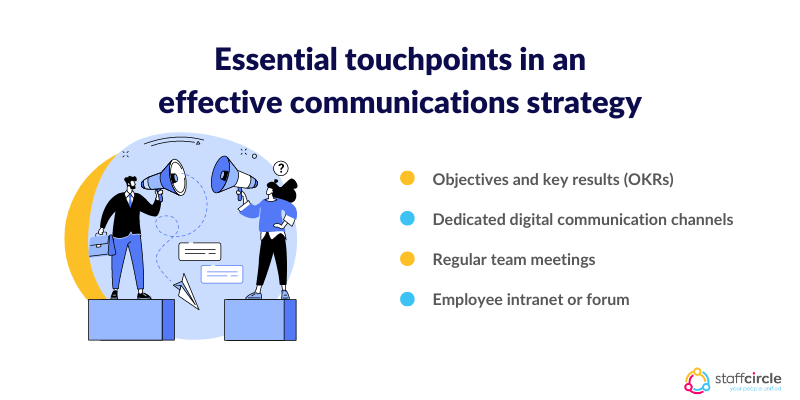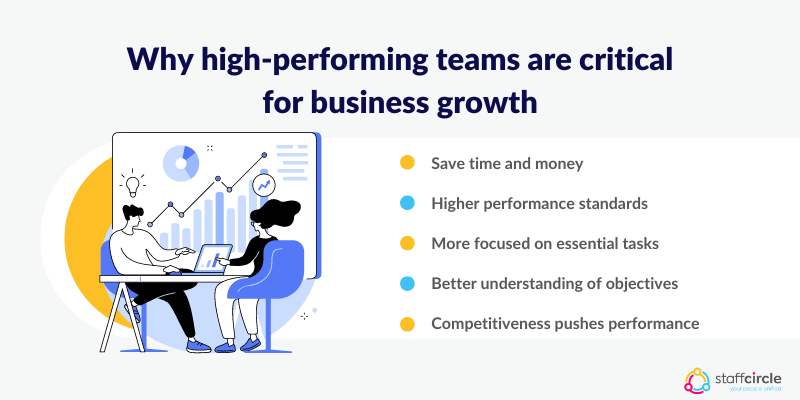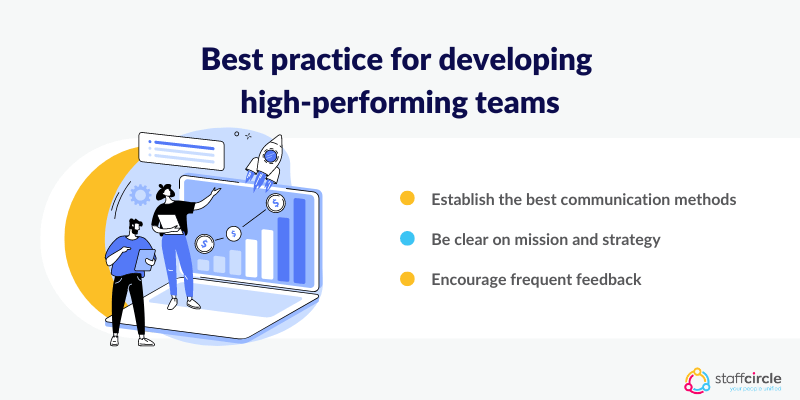This article explores the most important characteristics of high performing teams, from setting up a framework for clear communication to unifying individuals through a shared vision of the future.
Business leaders are at their most confident of success when they have high-performing teams under their wings. Such teams succeed by managing their individual skills to achieve ambitious goals, outperforming expectations and bringing exceptional value to the company.
What is the definition of a high-performing team?
A high-performing team is one in which each team member is focused on collective goals, using complementary skills to achieve group targets. In contrast to average- or under-performing teams, high-performing teams are able to communicate clearly and foster collaboration and innovation.
High-performing teams are enthusiastic about their work and dedicated to delivering outstanding results. They are often led by managers and team leaders who possess a broad managerial skill set, including exceptional communication skills and high levels of motivation.
Characteristics of high-performance teams
High-performance teams possess a series of characteristics that help them deliver outstanding results. These characteristics relate to how individual team members view their role in the collective context, as well as how these roles are carried out on a daily basis.
Let’s examine some of the core characteristics seen in high-performance teams that should be replicated whenever possible.
Open and clear communication
Just as with any team sport, clear and open communication between team members in the workplace is essential for victory. When people fail to articulate themselves clearly, communication breaks down and team effectiveness is negatively impacted.
To ensure communication within teams is always clear, a successful communications strategy needs to be put in place. This means creating a variety of touchpoints through which team members can communicate on a range of topics, both informal and formal.

Examples of these touchpoints include:
- Objectives and key results (OKRs) tracking software for monitoring and updating of short- and long-term team goals
- Dedicated MS Teams channels where team-members can discuss problem and brainstorm potential solutions
- Regular team meetings, whether in-person or through virtual team meetings for remote and/or hybrid workers
- Intranet forums, offering a place for long-form discussions and the sharing of more complex ideas
Such communication methods can be grouped together through the use of performance management software’s multi-channel communication platform.
Trust and mutual respect
Trust and mutual respect are the foundation of all healthy relationships, both in and out of the workplace, and both individually and collectively. Trust gives employees the confidence that their colleagues support them through successes and challenges, enabling the enthusiasm to experiment with new ways of working.
This is particularly important when addressing high-performance teams. As such, it’s perhaps not surprising there are countless trust building activities available that help teams to build trust. When people trust one another, mutual respect naturally follows.
An article from Forbes discussing the most important characteristics of high-performing teams makes the following observation about the importance of trust:
“The biggest factor separating high-performing teams from average teams is trust. Without trust, a team will never reach their full potential. With trust, a team finds their flow, feels more comfortable taking risks, and is able to work through challenges and conflicts as they arise.”
Diversity
As the workplace continues to become increasingly diverse, it’s important that teams are designed to reflect such diversity. This helps to ensure the broadest possible range of opinion is available to everyone, enhancing the potential options when working together as a team.
A report from Gartner outlined several reasons why diversity can help foster high-performance teams in the article, Diversity and Inclusion Build High-Performance Teams:
“Bringing diversity into the workforce is effective at a business level. The difference in employee performance between nondiverse and diverse organizations is 12%, with similar improvements in intent to stay factors. Having teams with diversity of age, gender, race, and ethnicity, or geographic and national culture reflects the very broad user base that companies have. This in turn allows the organization to better serve its consumers.”
Effective work practices
Effective work practices are the tried-and-trusted processes and protocols employees follow in order to accomplish their goals. In a sense, this relates to the “how things are done around here” aspect of any team culture or the business etiquette members of staff abide by in the company.
With high-performing teams, these work practices are what help keep each team member coordinated with their colleagues. This gives people the confidence that their colleagues will be able to fulfill one another’s roles should the need arise, and communicate any concerns clearly and concisely.
Team-first mentality
Employees who are capable of working the best with high-performing teams are ones who can leave their egos at home. Great team performance requires the individual members to prioritise the team’s requirements above their own. Such team members view their own skills in terms of how they can contribute to the greater good.
Practicing a team-first mentality isn’t just something team members must do; it’s also something executives and business leaders can help achieve. As the head of the overarching team that is the company at large, business leaders and executives can model the team-first mentality so that the standards are applied across the hierarchy.
Shared vision and clear direction
Setting and achieving goals is a fundamental aspect of what teams do together, and building these goals around an ambitious shared vision helps to create further unity. A clear sense of direction isn’t just about hitting work targets, but about those targets serving a broader collective objective.

When setting a shared vision with a clear direction for teams:
- Understand the current reality with honesty
- Plan for continuous involvement of all team members
- Allow for the unexpected to change the nature of the shared vision
- Make the vision’s definition the product of collaboration
- Commit to tangible actions to help bring the vision into reality
Continuous learning
When trying to understand exactly what a high-performance culture is, a recurring theme is the importance of continuous processes including communication and feedback. Learning and team development are other ongoing processes that are essential for the emergence of high performance teams.
Teams succeed or fail based on their collective skills and knowledge, so ongoing training and development is necessary to continually build on the existing talent stacks. Departmental charts can be used by managers and HR leaders to gain insights into the company’s broader skill set. From this, mentorship and coaching initiatives can be put into place that make the most of everyone’s unique talents, helping improve overall team performance.
.
Why high-performing teams are critical for business growth
It should go without saying that high-performing teams bring more value to a company than those with average or poor levels of performance. The nature of these advantages includes:
- Resolving conflicts quickly and effectively, saving valuable time and money
- Shared accountability – high-performing teams are less likely to let their team mates off the hook, leading to higher overall performance standards
- United by a shared vision that keeps them more focused on the tasks at hand
- Creating team members who play off one another’s strengths and weaknesses
- Understand their objectives and priorities better than average-performing teams
- Possess a healthy degree of competitiveness that pushes their performance above and beyond run-of-the-mill teams and is a sign of stronger dedication to the company’s overall strategy

Building a high-performing team
It’s one thing to understand the core elements and qualities that make up the characteristics of a high-performing team. Actually building a high-performance team requires careful consideration of a range of factors and processes.

When trying to put together a high-performance team, consider:
- Establishing the best methods for communication, including the software you intend to use to keep staff connected. If your teams are split between the office and remote working, for example through the hybrid work model, make sure you have a communications platform capable of messaging through PC/laptop, smart devices, and mobile phone SMS in case of emergencies.
- Being clear on your team’s mission and strategy. This point ties into the importance of a shared vision but bears repeating. This clarity of mission and strategy provides the backbone for motivation and direction.
- Encouraging feedback as frequently as possible. Teams perform best when all the members are on the same page at all times. This means consistent and honest feedback on a regular basis.
The secret to keeping high performers engaged
Finally, once a high performance team has been created, its team members need to be engaged to maintain optimal output. Engaging top performers allows companies to retain the best talent and ensure the creation of additional high-performance teams in the future.
Create space for healthy conflict
Ideas flourish when intelligent people are able to speak freely and engage in debate. By providing opportunities for high performers to engage with colleagues in this way, businesses allow their A-players to thrash out new ideas and hone their thinking skills.
Whether you’re using employee intranet software and communications platforms like MS Teams to create these spaces, or remote team building activities to develop interpersonal skills, the net result is stronger and healthier engagement.
Celebrate wins
When celebrating success, remember that it’s thanks to a team effort that success came about. High-performance teams might share the responsibilities and burdens associated with their tasks, but they can also share in the glory when they exceed expectations. Successes large and small should be shared whenever possible to make celebrating wins an ongoing practice within your business.
In Summary
With high-performing teams capable of delivering outstanding results with engaged and motivated individuals, it makes sense for business leaders to invest the necessary resources needed to create them.
By encouraging the characteristics of high-performing teams, managers and team leaders can help their employees overcome challenges and decisively achieve their objectives.






